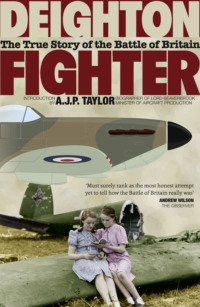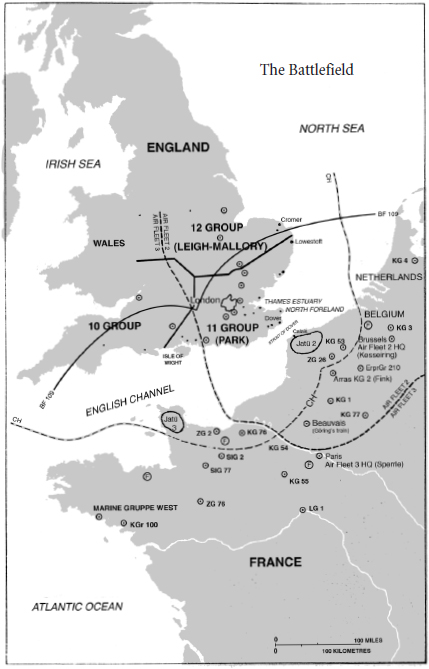
Fighter: The True Story of the Battle of Britain
The decisive difference between the British and the Germans is that the British, directed by Dowding, knew what they were doing and the Germans did not. Though the Germans constantly boasted of their overwhelming might in the air, they had never contemplated the problems involved. Like the British Air Marshals they simply clung to the dogma that the bomber would always get through. A full-scale attack on Great Britain had never entered into their plans. Indeed they had never considered a direct attack on Great Britain. All of them from Hitler downwards assumed that Great Britain would make peace once France was defeated, and even the defeat of France came much sooner than they had expected.
The armistice between Germany and France was signed on 22 June. Hitler said to General Alfred Jodl, ‘The British have lost the war, but they don’t know it; one must give them time, and they will come round.’ Hitler gave the British a month. Then on 19 July he addressed the Reichstag. After appealing to ‘reason and common sense’, he threatened the British with ‘unending suffering and misery’ unless they made peace. Lord Halifax, though himself inclining towards a compromise peace, was given the task of brushing Hitler’s peace offer aside on the radio. Hitler’s bluff had been called. He had now to make good his threats. On 21 July ‘Sea-lion’, the invasion of Great Britain, was decided on in principle. Ten days later the date for invasion was provisionally fixed for 15 September. Hitler was sceptical from the start and doubted whether the invasion was ‘technically feasible’. In other campaigns, such as in France and later in Russia, he had gone to the front himself and taken command. With the preparations for Sea-lion, he retired to the Berghof and watched the proceedings with detached curiosity.
Sea-lion has attracted a great deal of attention. As a practical operation it never existed. The army chiefs accumulated a considerable force with which they would overrun England once others had arranged the landings for them. They themselves made no contribution to the problem. Erich Raeder, the Grand Admiral who commanded an almost non-existent German fleet, regarded any invasion as impossible unless the British had already surrendered. He went through the motions of assembling river barges and coastal steamers in order to please the Generals and to avoid annoying Hitler. But he never took the talk of invasion seriously.
The Luftwaffe was therefore on its own. Göring was delighted to undertake the task. Like other air chiefs he believed that the bomber would always get through. ‘Eagle Attack’, the Luftwaffe offensive, and Sea-lion had no connexion. Hitler’s instruction was ‘to establish conditions favourable to the conquest of Britain’. But the Luftwaffe simply assumed that fleets of bombers, escorted by fighters, would sail over England and pulverise the British into surrender – Guernica on a larger scale. The Luftwaffe did not co-ordinate its acts with the needs of the other services. It made few attacks on British warships and often bombed harbours and airfields that the army would need if it ever landed. Luftwaffe strategy was in fact a supreme assertion of the theory favoured by the Air Marshals that bombing unsupported by land and sea forces could win a war.
The Luftwaffe’s attempt to reduce Great Britain by bombing failed, perhaps by a narrow margin. It also suffered from the German failure to consider its problems in advance. The attempt was a rushed affair where no German had time to stop and think, and in any case Göring rarely thought. Raeder was hypnotised by the prospect of the Royal Navy. No German remarked how British ships had been driven back by air attack during the Norwegian campaign. Again no one in Germany seems to have considered independent landings by paratroopers. Many people in England expected them to do so. At all events during my service in the Home Guard in the summer of 1940 I spent my time patrolling the Oxford gas works (with an unloaded rifle) in the firm belief that the entire weight of the German paratroop force would be directed against them.
The Battle of Britain was a fairly small affair. Hitler called off Sea-lion on 17 September and there was never any attempt to repeat it. Hitler was not seriously troubled by this set-back. Sea-lion was a botched plan, rushed up in a hurry and without importance in German strategy. Hitler’s mind was already set on the invasion of Russia and he did not fear that Great Britain, though unsubdued, could do him any real harm. The British on the other hand were invigorated. They believed that they had won a great victory or rather that the pilots of Fighter Command had won a great victory for them. And so they had. The British were a maritime people. They had learned from previous wars that their task was to survive, and victory in the Battle of Britain enabled them to do so. To some extent their confidence was misplaced. Great Britain came nearer to defeat in the prolonged Battle of the Atlantic against the U-boats than she did in the Battle of Britain. But psychologically the Battle of Britain was the more decisive.
The Battle of Britain had an unforeseen consequence, unpleasant to all concerned. Almost unintentionally the Germans turned from daylight to night bombing while the Battle was still on. They continued this campaign throughout the winter, as many British cities bore witness. The British attempted to counter this campaign by night bombing of their own. It seemed that the bomber would always get through after all. This expectation again proved wrong. No decisive results were achieved. The Germans virtually broke off their campaign in May 1941, perhaps because the Luftwaffe was needed in Russia and the Mediterranean. The British continued their campaign throughout the war, again indecisively. Bombing was not effective until long-range fighters could accompany the bombers, and this had to wait until 1944. Yet this had already been demonstrated in the summer of 1940.
The Battle of Britain had a more profound result. It put Great Britain back in the war. After the fall of France it seemed that Great Britain could make no stroke against Germany except such marginal acts as the attack on the French fleet at Oran. Hitler himself, to adopt MacArthur’s phrase, was content when he left Great Britain ‘to wither on the vine’. Suddenly the British showed that they were still in the war and still fighting. The Battle of Britain, though a defensive battle, was at any rate a battle. Thanks to it, Great Britain was still taken seriously as a combatant Great Power, particularly in the United States. As an uncovenanted blessing, Italy gave the British further opportunities for victory in the winter of 1940. These victories may have been irrelevant to the defeat of Germany but they showed that the British were in action all the same.
It would be agreeable to record that the victors were duly honoured as Nelson had been posthumously after the Battle of Trafalgar. Some of them were. Churchill honoured the fighter pilots with the immortal phrase, ‘Never in the field of human conflict was so much owed by so many to so few.’ One man was passed over. The Air Marshals were angry that their dogmatic faith in independent bombing had been disproved. The advocates of the ‘big wing’ received official approval after the Battle was over, as Len Deighton describes. On 25 November Dowding was relieved of his command and passed into oblivion. Yet ‘he was the only man who ever won a major fighter battle or ever will win one.’
Such were the strategical ideas and lack of them that lay behind the Battle of Britain. There were more practical considerations. In the last resort battles are decided by the men and machines that take part in them. I am afraid that many of us who write about war neglect this side of it and write in great sweeping terms. Len Deighton does not. After all, if the aeroplane had not been invented, the Battle of Britain could not have been fought, and quality of aircraft is the central feature of Len Deighton’s book. His brilliant analysis makes clear the technical problems of aircraft design in the interwar years. The Germans talked big and almost gave the impression that with such ingenuity and drive they ought to have won. I suspect that Erhard Milch is by way of being Len Deighton’s hero.
Yet, however ingenious the Germans were in design, and however forceful in production, they lost the Battle of Britain, or to be more precise did not win it, which comes to the same thing. Dowding’s superior strategy counted for much but each individual combat in the skies counted also. Here, too, Len Deighton provides a detailed account, fuller than any previously written, of how the British and Polish pilots prevailed. Indeed, in one way or another, he explains everything that happened in those days, now distant, of August and September 1940.

FIGURE 1. The Battlefield
The two German Air Fleets had a boundary line (black broken line) that extended over England. The German single-seat fighters (Bf 109s) were concentrated at Cherbourg and the Pas de Calais under the command of Jagdfliegerführer – Jafü – of Air Fleets 2 and 3 respectively. The black line (marked BF 109) shows the extreme range of the Messerschmitts, but combat would make this much shorter, as the pilots used full throttle and more fuel.
The most important bomber units – Kampfgeschwader 1 (KG 1), etc. – are shown as at the airfield of Geschwader staff. Kampfgruppe 100 (KGr 100), shown as the most westerly Luftwaffe unit, was the German pathfinder force.
From Marine Gruppe West four-engined Focke-Wulf FW 200s were sent out into the Atlantic – sometimes flying all the way round to Stavanger, Norway – and provided the weather reports that the Air Fleets needed to plan their attacks.
The vitally important RAF sector airfields, where the Operations Rooms were situated, are ringed; other fighter airfields are shown as dots. Bawdsey was the home of British radar development. The extent of the normal 10-metre Chain Home radar coverage, for aircraft up to 15,000 feet, is shown as a broken line (marked CH). It includes inland areas where the German aircraft formed up, but at this range it was little more than what the operators called ‘mush’.
Göring’s private train went back to Germany, and then to the Pas de Calais. It is shown at Beauvais, its original site, which was also the HQ of Fliegerkorps I. Other Fliegerkorps HQ are shown as F. These, like the Air Fleet HQs, had advanced HQs nearer the coast.
Lowestoft marks the place where Peter Townsend went after the Dornier Do 17, and Cromer is where Douglas Bader also found a Dornier. (See text for 11 July, beginning on p. 144.)
Конец ознакомительного фрагмента.
Текст предоставлен ООО «ЛитРес».
Прочитайте эту книгу целиком, купив полную легальную версию на ЛитРес.
Безопасно оплатить книгу можно банковской картой Visa, MasterCard, Maestro, со счета мобильного телефона, с платежного терминала, в салоне МТС или Связной, через PayPal, WebMoney, Яндекс.Деньги, QIWI Кошелек, бонусными картами или другим удобным Вам способом.
Вы ознакомились с фрагментом книги.
Для бесплатного чтения открыта только часть текста.
Приобретайте полный текст книги у нашего партнера:
Всего 10 форматов